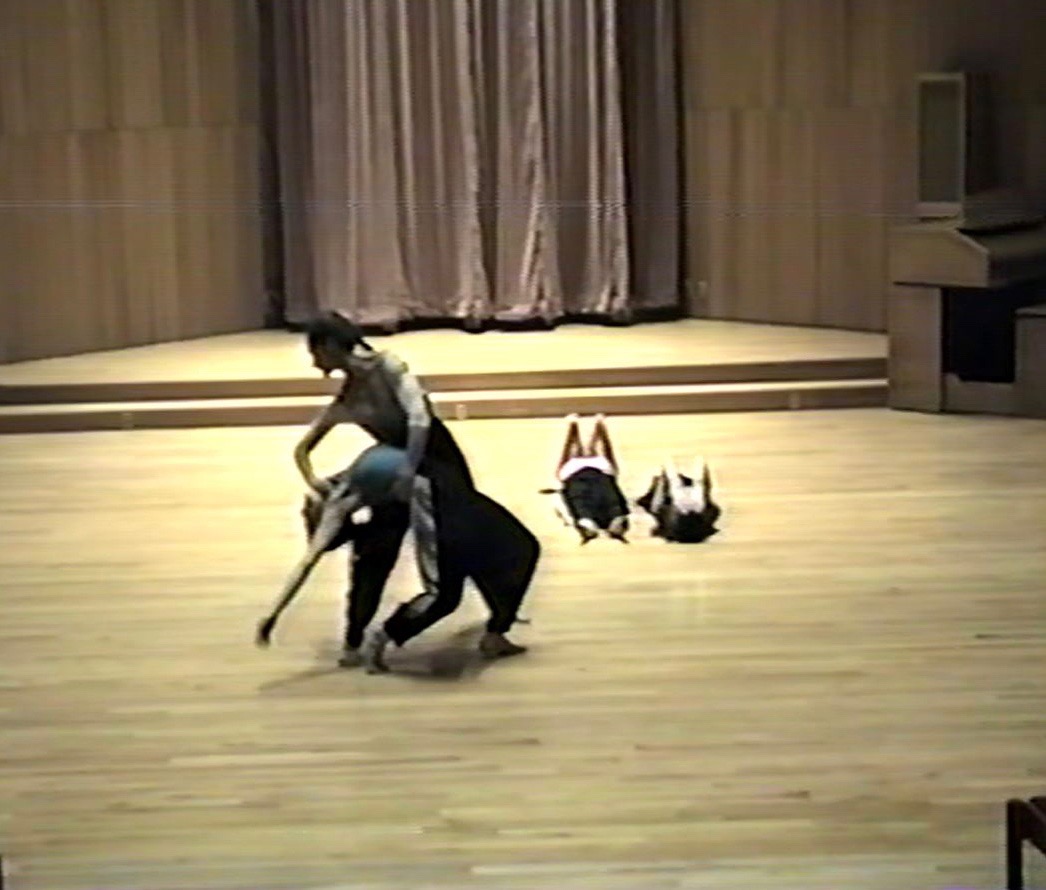Rehearsals began with four collaborating dancers. Deborah, Kezia, Susan and Beth (Bardin) had all helped to create Sisters. There was an ease and comfort of working together that I really appreciated with a text like the Akedah which is challenging and disturbing. I knew where I wanted to begin and that was opening with an angel ballet. Having been introduced to a wide variety of percussion instruments by Newman Taylor Baker I also had decided that we would use text, chanting and percussion to accompany the movement. That gives a certain freedom to choreographing as there is no music we need to follow. It also means we don’t have any form to follow or any musical drive to motivate the piece.
I asked Mark Childs, the cantor we had worked with in Let My People Go, to help create the cantorial score of the piece and to be in at least the first performance in December 1989. I was very grateful that Rabbi Norman Cohen had indicated his willingness to both speak before the piece was performed and to be part of the performance as well.
So we began with the angel ballet and played around with movement that might reflect a surreal appearance. This included the dancers walking on tiptoe backwards, making diagonal crossing paths. Ritual movement from the Kedusha prayer would be incorporated. The Kedusha is part of the Amidah, “the standing prayer which is central to every Jewish service.” The Kedusha “calls us to imitate the choirs of angels singing ‘Holy, holy, holy.’ There is a custom of rising on our tiptoes with every repetition of the word kadosh, holy.” (https://velveteenrabbi.blogs.com/blog/2015/08/shabbat-morning-gratitude.html)
We would take it a step further by turning the rising on the tiptoes to three jumps! And toward the end of the opening angel ballet which is accompanied by a triangle percussion instrument, Mark would elegantly and boldly chant the traditional prayer. Following that, the angels would birth the ram, inspired by Frederick Terna’s painting, to the accompaniment of the traditional sounds of the shofar.
Costumes can sometimes help create a mood. Somehow I wanted to have a very simple look to the piece and yet have the dancers have fabric that could indicate angel wings. I loved the pants we had for performing the piece M’Vakshei Or and thought they could work with a black leotard. The pants had a wrap-around design that gave a perfect place for fabric to be added. Sometimes when I don’t know what to do for costumes I wander in department stores, particularly in designer areas. As I was wandering around a store I came across a very simple and elegant chiffon poncho. It had an irregular cut to it. The price was over $200 and definitely out of our budget. I drew a quick sketch of how it was constructed and realized it would be simple to make. Next stop was the fabric store to pick out four different pastel colors in chiffon and enough extra to add some fabric to the pants. The costumes worked and gave just the effect I wanted.

The Angels birthing the ram. From l. to r. Beth Bardin, Susan Freeman (as the ram), Deborah Hanna, and Kezia Gleckman Hayman in the chapel at Hebrew Union College – Jewish Institute of Religion, NYC. Much to my disappointment we have neither formal professional pictures of this piece, nor any taken in dress rehearsal. Luckily we have a video of the dress rehearsal. So I have copied the VHS to a DVD and then to an MP4 file. Using a screen shot I have captured some moments from the piece that I will be sharing in the blog.
The next section of the piece is based on exploring this line of text: “After these things, God put Abraham to the test.” What were these things? A duet begins between Deborah and Susan inspired by this poem:
Ishmael the older brother, boasted of his
Blood and brayed: My blood was drained when I was thirteen:The younger Isaac whispered: if God
Wishes to take me, let God take all of me.

At one of the early rehearsals Susan arrived with two poems she had written that she offered for the piece. With her permission I share these poems which became part of the piece (with slight variations) and inspired choreography.
Abraham’s Trial
Hagar is crying – –
Banished and weary – –
In the wilderness.
The desert horizon is
Thirst and starvation.
Collapsing to her knees
She buries her face – –
Not to watch as Death’s path
Unwinds its parched fingers
Ready to take her son
In its suffocating embrace.
Hagar is crying in the – –
After these things
Abraham was put on trial. Abraham is crying,
Forced to turn,
Return to the place
Familiar in his dreams – –
Wilderness.
(written by Rabbi Susan Freeman)

The piece continues using the second poem that Susan wrote:
The Birth of Isaac
Before these things
Sarah lay breathless.
Her eyes full, her cheeks damp,
Abraham holding their newborn son,
Joyous astonishment – –
And Sarah laughed.
Amazing is the One
Who creates life and death,
Laughter and tears.
And they called the child Isaac.
After these things
Sarah lay breathless,
Her eyes full, her cheeks damp.
A dance follows with Deborah as Sarah holding her new son and the three other dancers giggling and laughing in movement until the movement changes to a more hysterical, crying tone.
As the story unfolds Norman and Mark join the dancers on stage portraying Abraham and Isaac.

I could go on describing how the piece continues but instead let me invite you to click this link and see the final rehearsal for yourself.
[print_link]











